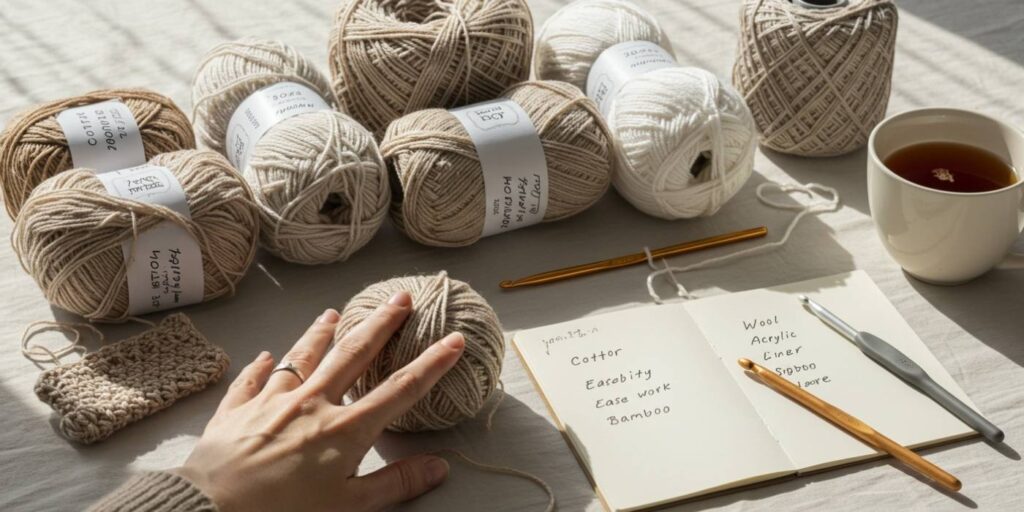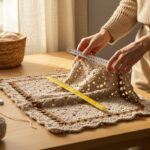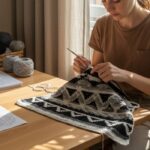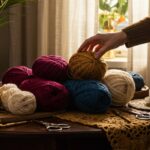Introduction: Your Hook Into the Wonderful World of Crochet
There’s something magical about wrapping your fingers around a hook, looping yarn through stitches, and watching a beautiful creation emerge — stitch by stitch, row by row. Whether you’re crocheting your first scarf, a cozy blanket, or even just a wonky little dishcloth, the journey begins with one crucial decision: Which yarn should you choose?
It’s easy to walk into a craft store, get overwhelmed by rainbow-colored skeins, and grab the prettiest ball you see. But here’s the truth: not all yarns are created equal — especially for beginners. The fiber you pick can make the difference between a frustrating, tangled mess and a joyful, satisfying first project.
In this article, we’ll walk you through everything you need to know to choose the perfect yarn fiber for your very first crochet adventure. We’ll break down the most common fibers (like acrylic, cotton, wool, and blends), explain their pros and cons, and help you match the right material to your skill level, project type, and personal preferences. Along the way, we’ll share real-life tips, easy comparisons, and gentle guidance — because no one should feel intimidated by yarn labels or fiber content percentages.
By the end, you’ll feel confident walking into any store (or scrolling through any online shop) and picking a yarn that sets you up for success — not stress. Let’s unravel this mystery together, one soft, squishy skein at a time.
Why Fiber Choice Matters More Than You Think
You might be thinking, “It’s just yarn — how different can it really be?” Oh, sweet friend, let me tell you: very different.
Imagine trying to learn how to drive… in a race car. Sure, it’s exciting, but the sensitive steering, roaring engine, and lightning speed might overwhelm you before you even leave the driveway. Now imagine learning in a gentle, forgiving sedan — smooth, predictable, and built for beginners. That’s the difference between choosing a tricky fiber (like silk or alpaca) versus a beginner-friendly one (like medium-weight acrylic).
Fiber affects:
- How easy it is to see and work your stitches
- How forgiving the yarn is when you make mistakes
- How your finished project will feel, drape, and hold up over time
- Whether your hands get tired or your hook slips constantly
I remember my first crochet project — a lumpy, misshapen granny square made with fuzzy eyelash yarn. I couldn’t see my stitches, my hook kept catching on the fluff, and I nearly gave up before finishing the first round. Don’t be like past-me. Start smart.
Pro Tip: For your first project, prioritize stitch definition and ease of use over aesthetics. You can always graduate to fancy fibers later — but building confidence comes first.
Acrylic: The Beginner’s Best Friend (Seriously!)
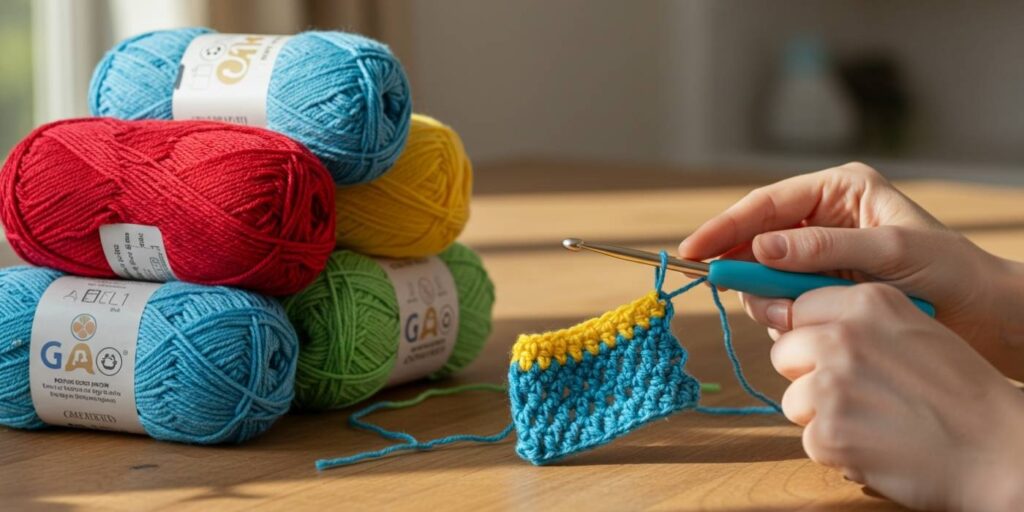
Let’s start with the MVP of beginner yarns: acrylic.
Acrylic is synthetic, affordable, widely available, and comes in every color imaginable. It’s also incredibly forgiving — if you drop a stitch or need to frog (aka “rip out”) your work, acrylic bounces back without complaint. No stretching, no fraying, no drama.
Here’s why acrylic is perfect for your first project:
✅ Budget-friendly — Most skeins cost under $5, so if you mess up, it’s not a financial tragedy.
✅ Durable & machine-washable — Great for scarves, blankets, or anything that’ll see regular use.
✅ Stitch definition — Smooth textures make it easy to see where to insert your hook.
✅ Consistent thickness — Unlike some natural fibers, acrylic rarely has knots or sudden thin spots.
A popular choice? Red Heart Super Saver or Lion Brand Basic Stitch. Both are medium weight (Category 4), soft enough for wearables, and available just about everywhere — from Walmart to your local yarn shop.
“But isn’t acrylic itchy or cheap-feeling?” Not anymore! Modern acrylics have come a long way. Many feel buttery soft and drape beautifully. And yes — while purists may turn their noses up at synthetic fibers, remember: your first project is about learning, not impressing judges at a fiber fair.
Try This: Grab a worsted-weight (Category 4) acrylic in a light, solid color. Avoid dark shades or variegated yarns for now — they make it harder to see your stitches.
Cotton: Crisp, Cool, and Perfect for Practical Projects
If acrylic is the friendly sedan, cotton is the reliable pickup truck — sturdy, practical, and great for hauling… I mean, crocheting… useful things.
Cotton yarn is natural, breathable, and holds its shape beautifully. It’s ideal for:
- Dishcloths and washcloths
- Market bags and totes
- Summer tops or lightweight scarves
- Baby items (if labeled as machine-washable and soft)
Pros of Cotton:
✅ Sturdy & holds shape — No stretching out over time.
✅ Great stitch definition — Especially with mercerized cotton (like Lily Sugar’n Cream or Lion Brand 24/7 Cotton).
✅ Cool to the touch — Perfect for warm-weather wearables.
✅ Hypoallergenic — Great for sensitive skin or baby gifts.
Cons to Consider:
⚠️ Less stretch — Can feel stiff or unforgiving while crocheting.
⚠️ Heavier — Your wrists may tire faster than with acrylic.
⚠️ Can split — Some cottons fray if you’re not careful with your hook.
Cotton’s lack of “give” means it won’t hide uneven tension — which is actually good for learning! You’ll train your hands to keep stitches consistent, which is a valuable skill.
Beginner Tip: Start with a cotton blend (like 80% cotton, 20% acrylic) for a little more flexibility. Or pair pure cotton with a slightly larger hook than recommended — it’ll help your stitches flow more easily.
Wool: Warm, Wonderful… But Maybe Not for Round One
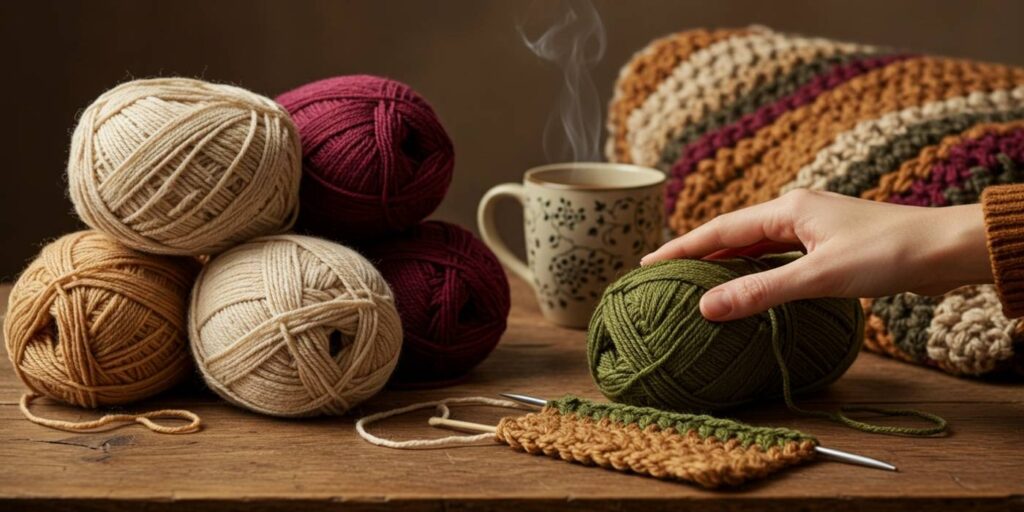
Ah, wool. The fiber of legends. Cozy sweaters, heirloom blankets, and winter hats that feel like hugs? Thank wool.
But — and this is a big but — wool is not always beginner-friendly.
Let’s break it down:
✅ Warm & elastic — Wool stretches and recovers beautifully, making it forgiving for tension issues.
✅ Great stitch definition — Especially in smoother wools like merino.
✅ Naturally water-resistant & odor-resistant — Perfect for outdoor wearables.
⚠️ Can felt or shrink — If washed incorrectly (hot water + agitation = disaster).
⚠️ Some types are itchy — Not all wool is created soft. Superwash merino? Yes. Scratchy rug wool? Hard no.
⚠️ Pricey — Good wool costs more, and mistakes hurt your wallet.
⚠️ Splitting & halo — Some wools are fuzzy or prone to splitting, which frustrates new crocheters.
That said — if you’re set on trying wool, go for a superwash merino (like Malabrigo Worsted or Cascade 220 Superwash). It’s machine-washable, soft, and behaves well. But honestly? Save it for Project #2 or #3.
Fun Fact: Wool’s natural elasticity makes it easier to fix mistakes — stitches pop right back into place. So once you’re comfortable with the basics, wool becomes a joy to work with.
Blends: The Best of Both Worlds (Often!)
Sometimes, you don’t have to choose between acrylic and cotton, or wool and silk. Blends give you the best qualities of multiple fibers — and often at a great price.
Popular beginner-friendly blends:
- Acrylic + Cotton (e.g., Lion Brand Comfy Cotton Blend) — Soft, breathable, with a little stretch.
- Acrylic + Wool (e.g., Patons Classic Wool Worsted) — Warmth of wool, ease of acrylic.
- Bamboo + Cotton — Silky drape, cool feel, great for summer garments.
Why blends rock for beginners:
✅ Balanced texture — Less extreme than pure fibers.
✅ Forgiving tension — Stretch from synthetics or wool helps hide inconsistencies.
✅ Unique drape & feel — Lets you experiment without going full luxury.
Watch Out For: Some blends (especially with mohair, alpaca, or silk) can be slippery or fuzzy. Stick to blends where acrylic or cotton is the first ingredient on the label — that means it’s the dominant fiber.
Pro Tip: Check the care label. A blend that’s machine-washable and dryable? Gold star for practicality.
Fibers to Avoid (For Now): The “Pretty But Tricky” Club
We all fall in love with that sparkly, fuzzy, silky, eyelash, or super-thin lace-weight yarn on the shelf. It looks gorgeous. It feels luxurious. It whispers, “Take me home!”
Resist. (At least for now.)
Here’s why certain fibers are better saved for later:
🔸 Mohair & Angora — Fuzzy halo hides stitches. You won’t know if you’ve skipped a stitch or added an extra one.
🔸 Silk or Bamboo (pure) — Slippery. Your hook will slide right out, and stitches will feel loose and unstable.
🔸 Lace Weight or Thread — Too thin for learning. You’ll strain your eyes and get discouraged.
🔸 Novelty Yarns (eyelash, bouclé, ribbon) — Fun for accents, impossible for learning stitch patterns.
🔸 Super Bulky or Jumbo — Uses huge hooks and works up fast — but mistakes are glaring and hard to fix.
Think of these like dessert. Delicious? Absolutely. But you wouldn’t start a meal with chocolate cake. Start with the “main course” fibers — acrylic, cotton, blends — then treat yourself later.
Story Time: My friend Jenna bought a skein of glittery mohair for her first scarf. Three hours in, she burst into tears because she couldn’t tell where her last stitch ended. We switched her to smooth acrylic — and she finished her scarf in two days, smiling the whole time.
How to Read a Yarn Label (Without Panicking)
Yarn labels look like they’re written in code. But once you know what to look for, they’re actually super helpful!
Here’s your cheat sheet:
1. Yarn Weight Symbol (The Number in the Swatch):
Look for a number inside a skein icon. Beginners, stick to #4 (Medium/Worsted). It’s the Goldilocks zone — not too thin, not too thick.
2. Fiber Content:
Lists percentages. “100% Acrylic” = easy. “50% Wool, 30% Alpaca, 20% Nylon” = save for later.
3. Yardage & Weight:
Tells you how much yarn you’re getting. Compare prices by cost per yard — not per skein.
4. Recommended Hook Size:
Start here! You can adjust later, but it’s a great baseline.
5. Care Instructions:
Machine washable? Yes, please. “Dry clean only”? Not for your first dishcloth.
6. Dye Lot Number:
CRUCIAL. If you need more than one skein, make sure the dye lot # matches — or your project may have color variations.
Quick Hack: Take a photo of the label before you leave the store. Or save the product page if buying online. You’ll thank yourself later.
Matching Fiber to Project: A Simple Guide
Not sure what to make first? Here’s a quick-reference table to pair fiber with project:
| Scarf or Cowl | Acrylic or Acrylic Blend | Soft, warm, forgiving, affordable |
| Dishcloth or Washcloth | 100% Cotton | Absorbent, sturdy, holds shape |
| Baby Blanket | Acrylic or Cotton Blend | Machine-washable, hypoallergenic, soft |
| Market Tote Bag | Cotton or Cotton Blend | Strong, holds structure, won’t stretch out |
| Beanie or Hat | Acrylic/Wool Blend | Warm, stretchy, fits well |
| Decorative Pillow | Acrylic or Chenille (later!) | Soft, plush, hides imperfections |
Remember: Your first project should be small and simple. A scarf, dishcloth, or basic beanie is perfect. Avoid complex patterns or garments with shaping — save those for when you’re confident.
Where to Buy Yarn (Without Getting Overwhelmed)
You don’t need a specialty yarn store to get started. In fact, big-box craft stores are perfect for beginners.
Best Places to Start:
🛒 Michaels, Joann, or Hobby Lobby — Huge selection of beginner-friendly acrylics and cottons. Frequent coupons!
🛒 Walmart or Target — Budget-friendly basics like Red Heart, Lily Sugar’n Cream, or Loops & Threads.
🛒 Online (Amazon, LoveCrafts, WeCrochet) — Read reviews, compare prices, and zoom in on texture photos.
Avoid (for now):
- Etsy (unless buying from a trusted shop) — Hard to judge texture/fiber without seeing it.
- Local yarn shops with only luxury fibers — Beautiful, but potentially overwhelming and pricey.
Pro Tip: Buy just ONE skein to start. You don’t need a whole stash yet. Master one project, then build from there.
Final Tip: Touch It Before You Buy It
If you’re shopping in person — squeeze the yarn.
Does it feel soft? Smooth? Stiff? Scratchy? Does it make you want to snuggle it or put it down immediately?
Your hands will be spending hours with this yarn. Make sure it’s a pleasant companion.
Also — unravel a few inches and try a test stitch or two in the store (many shops have sample hooks). Does it glide easily? Do the stitches look clear? Does it feel comfortable in your grip?
Trust your instincts. If it feels “off,” keep looking. The right yarn is out there — and it’s probably smiling at you from the clearance bin.
Conclusion: You’ve Got This — One Stitch at a Time
Choosing your first yarn doesn’t have to be scary, overwhelming, or expensive. In fact, it can be one of the most exciting parts of your crochet journey — like picking the perfect crayon before drawing your first masterpiece.
Remember:
🔸 Start with acrylic or cotton — they’re kind to beginners.
🔸 Avoid fuzzy, slippery, or super-thin fibers until you’re more confident.
🔸 Match the fiber to your project — practical choices make better first impressions.
🔸 Read the label, check the dye lot, and — most importantly — touch the yarn before you buy.
Crochet isn’t about perfection. It’s about progress. It’s about the rhythm of your hook, the satisfaction of a finished row, and the pride of saying, “I made this.”
So grab that skein. Chain two. Make your first single crochet. And welcome to a craft that will warm your hands, your heart, and maybe even your future living room couch.
Now it’s your turn!
What yarn did you use for your first crochet project? Loved it? Hated it? Share your story in the comments — and if you’re just starting out, tell us what you’re planning to make! Let’s cheer each other on, one stitch at a time. 🧶

Daniele Ferreira is passionate about the world of crochet, dedicating her time to exploring techniques, creating unique pieces, and sharing her knowledge with beginners and aficionados alike. With attention to detail and creativity, she transforms yarn into true works of art, inspiring others to discover the beauty and joy of this manual art.

